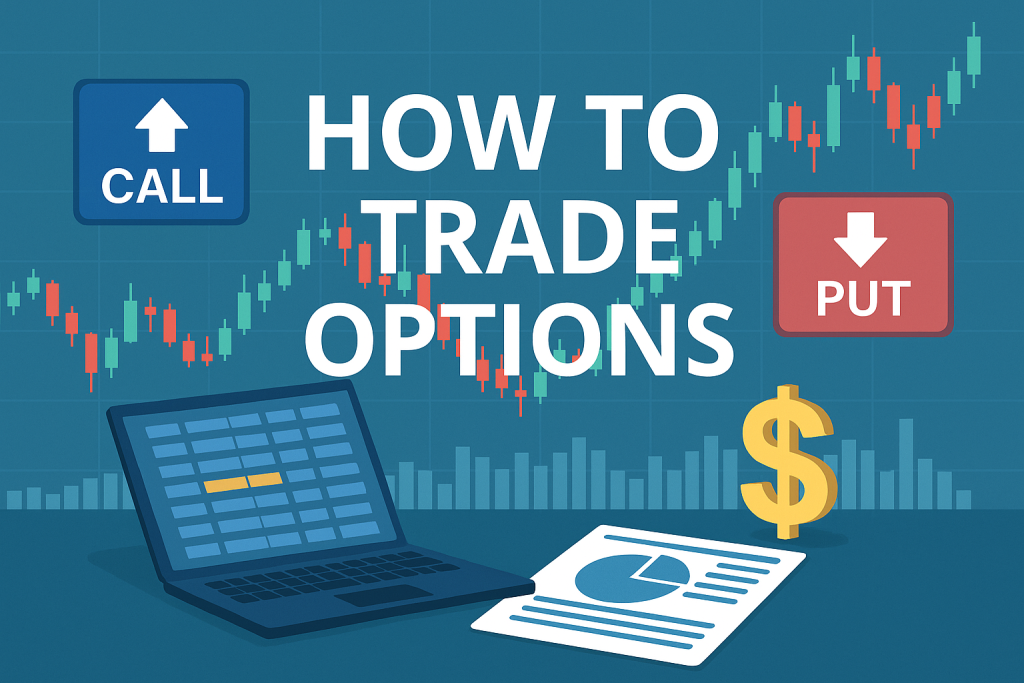How to Trade Options: A Beginner’s Guide (2025)

Options trading offers flexibility, leverage, and unique strategies that can suit any market condition. Whether you want to hedge your portfolio or generate profits in volatile markets, understanding how to trade options is a valuable skill.
This guide will walk you through everything you need to get started.
What Are Options?
Options are financial contracts that give the buyer the right, but not the obligation, to buy or sell an underlying asset at a specific price before a set expiration date.
There are two types:
- Call Option: Right to buy
- Put Option: Right to sell
Key Terms You Should Know
- Strike Price: The fixed price at which the option can be exercised
- Premium: The cost to buy the option
- Expiration Date: The last date the option can be exercised
- In-the-Money (ITM): Option has intrinsic value
- Out-of-the-Money (OTM): Option has no intrinsic value
Step-by-Step: How to Trade Options
1. Open an Options Trading Account
Choose a broker that offers options trading like Zerodha, Upstox, Robinhood, Thinkorswim, or Interactive Brokers.
You may need to:
- Complete a risk disclosure form
- Pass a basic knowledge test
- Fund your account with the required capital
2. Choose a Stock or Index
Look for high-volume, well-known stocks or indices. Examples include:
- AAPL, TSLA, NIFTY, BANKNIFTY
- Stocks with upcoming earnings or volatility
3. Decide the Option Type
- Bullish? → Buy a Call
- Bearish? → Buy a Put
If you’re neutral or expect low volatility, consider strategies like Iron Condors or Straddles (advanced).
4. Select Strike Price & Expiration
Use the option chain to:
- Choose strike prices close to current stock price (ATM)
- Select expiry: Weekly, Monthly, or LEAPS (Long-Term)
5. Analyze the Option Premium
Check factors affecting price:
- Implied Volatility (IV)
- Time to expiration
- Stock price movement
- Intrinsic vs. extrinsic value
Use tools like Options Greeks (Delta, Gamma, Theta, Vega) to guide decisions.
6. Place the Order
Decide between:
- Buy to Open (BTO) or Sell to Open (STO)
- Market order vs. Limit order
Monitor your trade closely and prepare an exit plan.
7. Close or Exercise the Position
Before expiry, you can:
- Sell the option to capture gains/losses
- Exercise the option (rare in retail)
- Let it expire worthless (if OTM)
Always track P&L and fees.
Common Beginner Strategies
- Long Call – Buy call expecting price rise
- Long Put – Buy put expecting price drop
- Covered Call – Sell call while holding stock
- Protective Put – Buy put to hedge your holdings
Final Tips
- Start with paper trading or demo accounts
- Limit exposure to 2–5% of capital per trade
- Use stop-loss or alert systems
- Avoid buying deep OTM options with short expiries (high risk)
FAQs
Q1. Is options trading risky for beginners?
A: Yes, it can be. Start small, use basic strategies, and always manage risk.
Q2. Can I lose more than I invest in options?
A: Only if you sell options without holding them (naked selling). Buying options limits your risk to the premium paid.
Q3. What’s the best app to trade options?
A: In India: Zerodha, Upstox. In the U.S.: Robinhood, Thinkorswim, Tastytrade.
Q4. Can I trade options with ₹10,000 or $100?
A: Yes, but your choice of trades will be limited to lower-priced stocks or weekly expiries.
Q5. Do I need to be an expert in technical analysis?
A: Not initially. But understanding price action, support/resistance, and trend indicators is helpful.